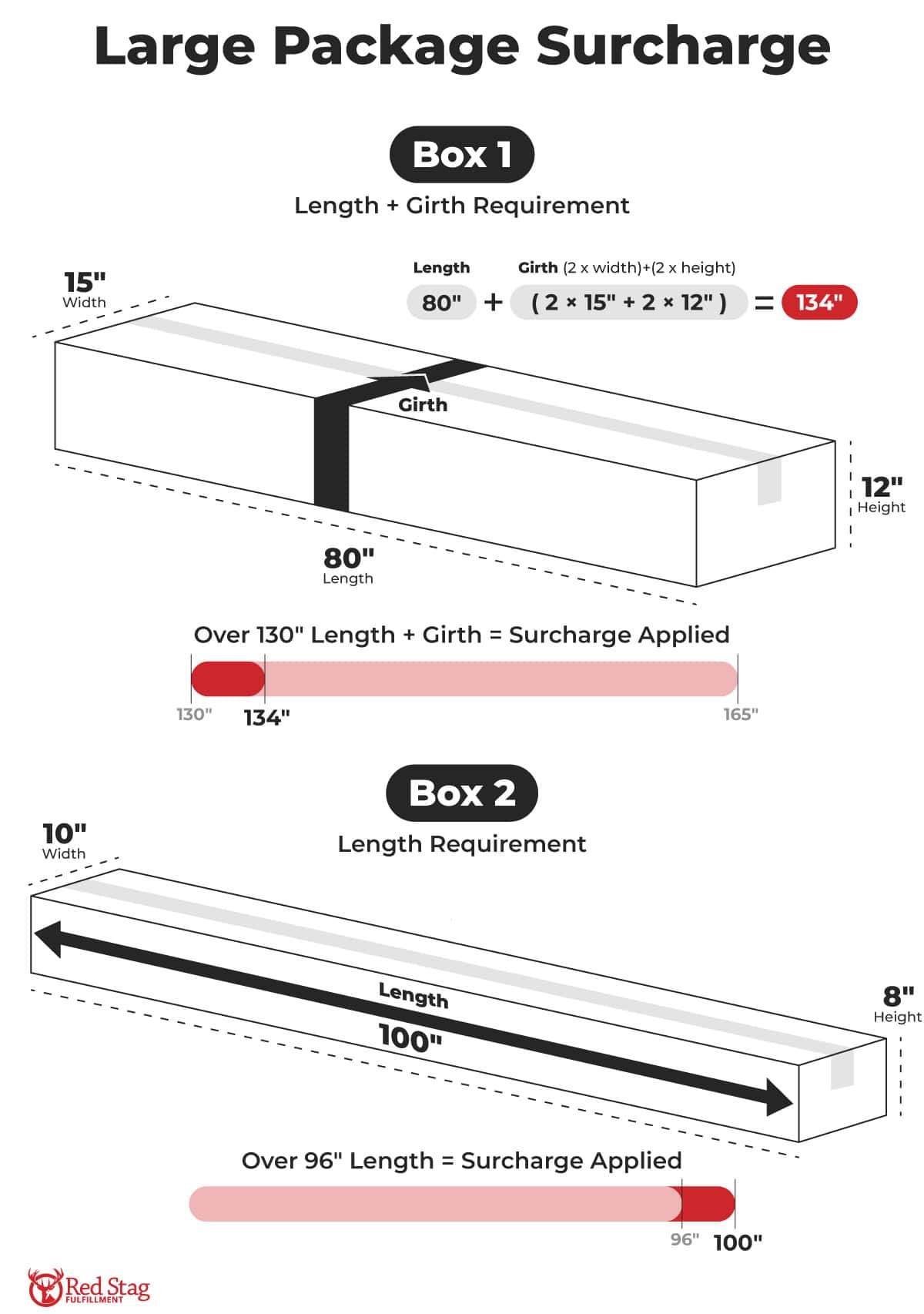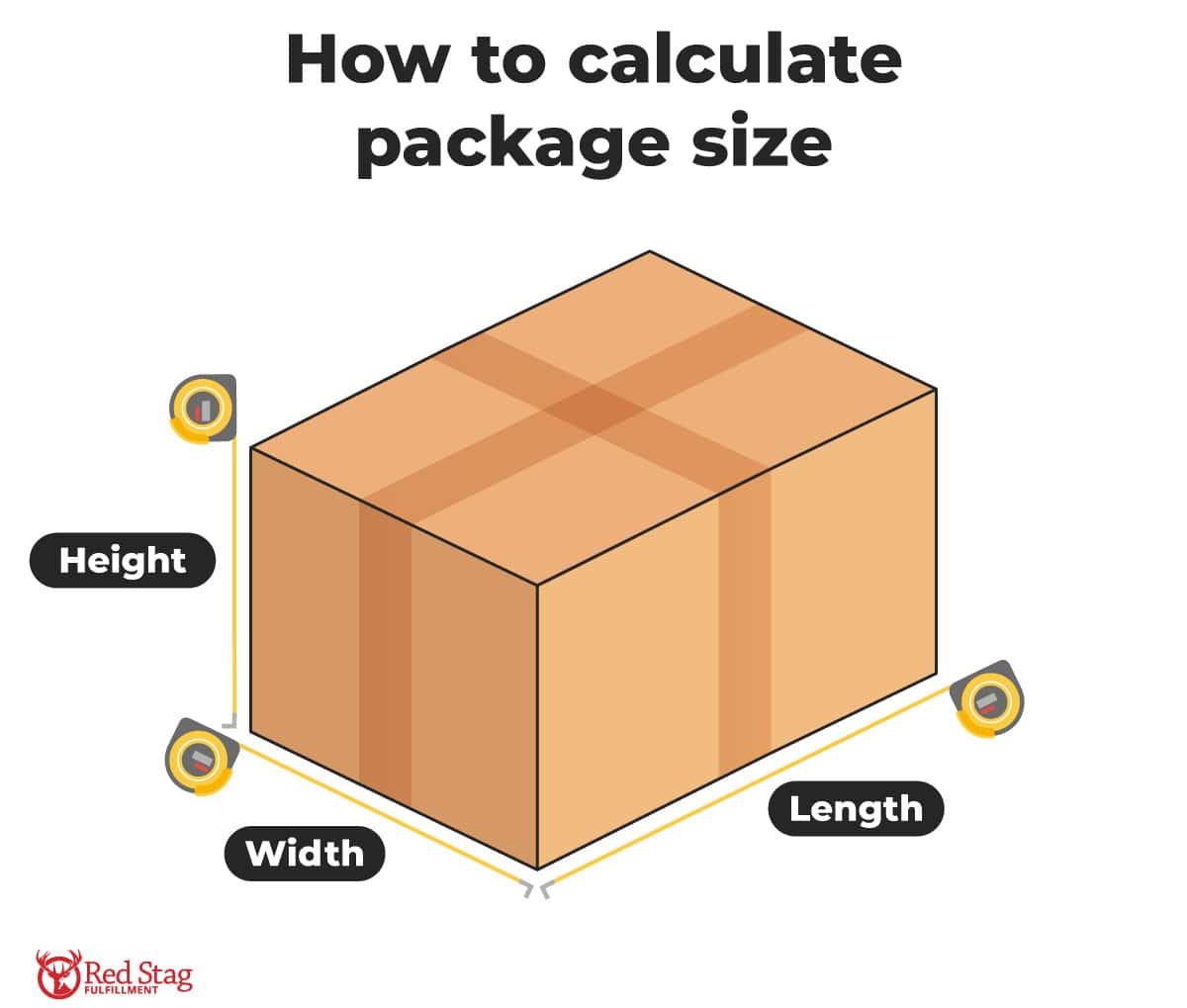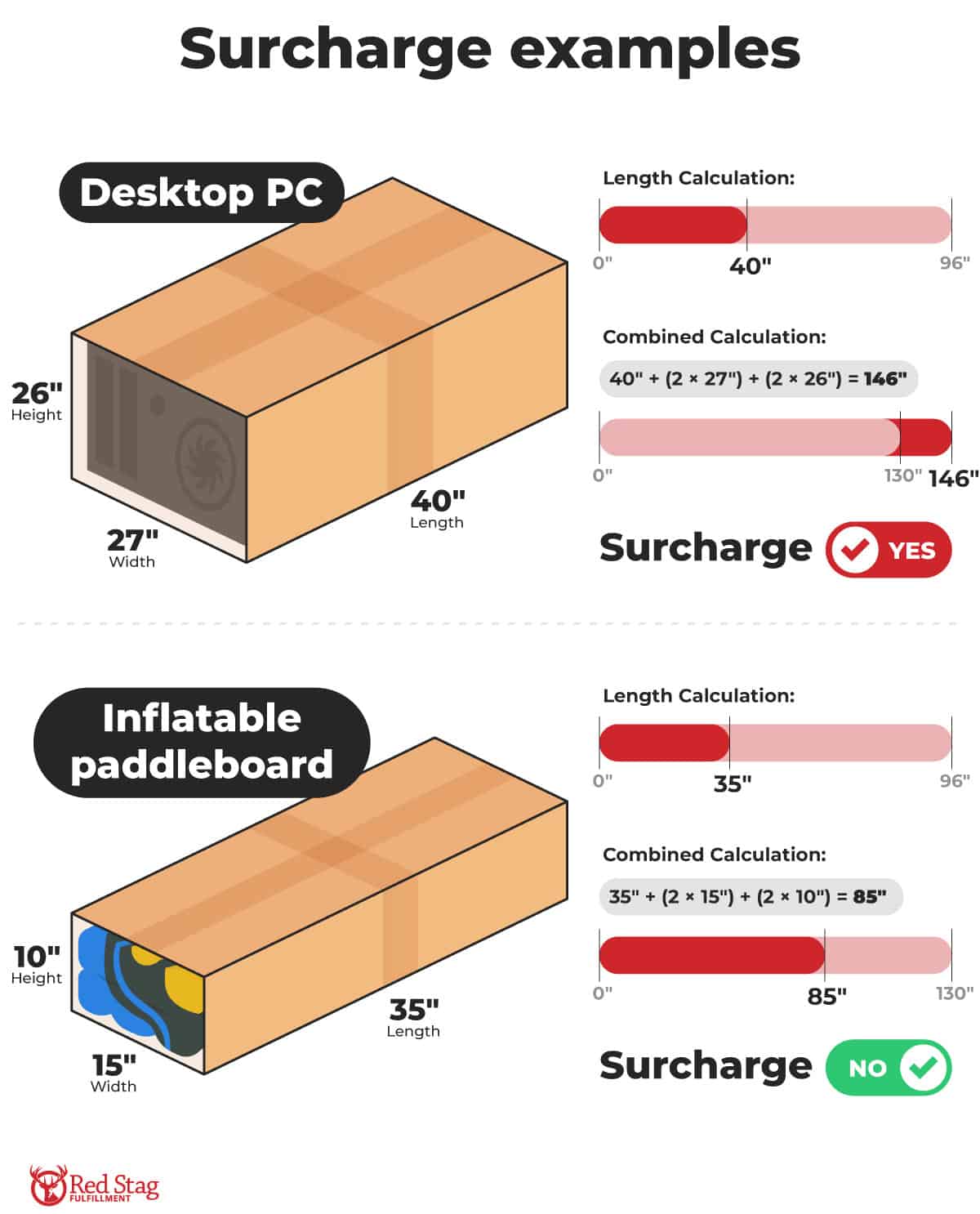Are UPS Large Package Surcharges unexpectedly eating into your shipping budget?
These hidden fees can sometimes exceed $250 per package, dramatically inflate your shipping costs, and disrupt your bottom line.
In this comprehensive guide, we’ll explain:

What the UPS Large Package Surcharge is

How it’s calculated

How much it costs

How to avoid it and reduce other UPS surcharge fees

TL;DR:
Key takeaways

Large Package Surcharge: Applies if the longest side is over 96” or the combined length + girth exceeds 130”.

Cost impact: Can add over $250 per package.

Minimum billable weight: A Large Package Surcharge is billed at a minimum of 90 lbs, regardless of actual or dimensional weight.

Additional fees: Other surcharges (e.g., Dimensional Weight, Residential Delivery, Fuel) may also apply.
What is a UPS Large Package Surcharge?
A UPS Large Package Surcharge is an extra fee for packages that exceed UPS’ standard size limits.
This surcharge is triggered when packages meet specific dimensional criteria in one of two ways:

The combined length plus girth (calculated as 2 x width + 2 x height) exceeds 130“ but is less than 165”.

The longest side (referred to as length) exceeds 96”.
For international packages, the same 130” combined length plus girth threshold applies, but there’s no length limit.

These oversized packages incur additional costs because they require extra handling, storage space, and labor to process. Even if the actual weight is lower, large packages are billed at a minimum of 90 lbs, except for UPS Ground shipments with freight pricing, which are exempt from this requirement.
The Large Package Surcharge is just one of several fees UPS may apply to a shipment. We’ll cover other fees and how to minimize them in the following sections.

NOTE: When a package qualifies for the Large Package Surcharge, UPS does not assess an Additional Handling charge.
Current Large Package Surcharge rates
Here’s a table with the current Large Package Surcharge prices for both domestic and international shipments (domestic packages are based on shipping zones):
| Delivery type | Zone 2 | Zones 3-4 | Zones 5+ | International |
|---|---|---|---|---|
| Commercial | $205.00 | $225.00 | $250.00 | N/A |
| Residential | $240.00 | $260.00 | $297.50 | N/A |
| International | N/A | N/A | N/A | $220.00 |

NOTE: At the time of writing, the rates for both length + girth exceeding 130″ and length exceeding 96″ are the same, but they are listed separately, suggesting they could differ in the future. For current rates, contact UPS directly or visit their website.
How to calculate your package size
Key maximum limits:

Length: Maximum of 96” before the surcharge applies.

Combined length plus girth: Exceeding 130” triggers the surcharge.
To determine if your shipment will incur a Large Package Surcharge, you’ll need to measure the package. Always measure after packing. Final package dimensions matter, not item dimensions.
Real-world examples

To give you an idea of how to calculate package size, here are a couple of examples:

Box dimensions: 40″ × 27″ × 26″

Length (40″) doesn’t exceed 96″ threshold

Combined calculation: 40″ + (2 × 27″) + (2 × 26″) = 146″

Result: Exceeds 130″ limit—the Large Package surcharge applies

Box dimensions: 35″ × 15″ × 10″

Length (35″) is well under the threshold

Combined calculation: 35″ + (2 × 15″) + (2 × 10″) = 85″

Result: Under 130″ limit—no Large Package surcharge

Dimensional weight calculation
While the UPS Large Package Surcharge is an important consideration, dimensional weight (DIM weight) can also affect pricing for large (but lightweight) items.
In simple terms, dimensional weight means you pay based on how much space your package occupies, not just its weight. If your package is large but light, the shipping cost could be higher due to its size.
UPS charges based on the greater of the actual weight or dimensional weight.
To calculate dimensional weight, multiply the length, width, and height of your package (in inches) and divide by 166 for retail shipments or 139 for regular shipments.

PRO TIP: You don’t have to calculate dimensional weight manually. Use Red Stag Fulfillment’s dimensional weight calculator instead.
For example, if your package measures 10″ × 20″ × 30″, the calculation would be:
(10 × 20 × 30) ÷ 139 = 44 lbs
If your package weighs less than 44 lbs, UPS will charge you based on the dimensional weight.
This means you’d pay for 44 lbs of shipping, even if your package only weighs 20 lbs.

NOTE: For packages that have incurred the Large Package Surcharge, UPS applies a minimum billable weight of 90 lbs, even if both physical and dimensional weights are lower.
Beware of exceeding the Over Maximum Limits range (triggers a flat $1,325 charge)
Although the UPS Large Package Surcharge covers oversized items, there’s an even stricter threshold to watch out for: Over Maximum Limits.
UPS typically does not accept packages that exceed these limits:

Weight: 150 lbs

Length: 108”

Combined size: 165” total of combined length + girth (2 x width + 2 x height)
If a package is identified in UPS’ system as exceeding their maximum size restrictions, it will either be returned to the sender or incur a substantial flat fee of $1,325 ($1,375 for international shipments, subject to change), significantly higher than the Large Package Surcharge.
The UPS Large Package Surcharge rarely appears alone on your shipping bill.
When shipping large items, multiple surcharges often stack together, significantly increasing the final cost.
The most frequent surcharge combinations that affect large packages include:

Large Package Surcharge: The core fee for packages exceeding UPS dimensional limits

Dimensional Weight: Applies when dimensional weight exceeds physical weight

Additional Handling: Applies to packages requiring special handling due to weight, size, or packaging (not added if Large Package Surcharge is already applied)

Residential Delivery: Added for home deliveries

Fuel: Varies weekly based on fuel costs
There are a few other surcharges not mentioned here, like Incorrect Weight, Extended Delivery Area (DAS), Dangerous Goods, and Delivery Reattempt, which only apply in some specific situations.

PRO TIP: For businesses that regularly ship via UPS, regular invoice audits are crucial for catching incorrect or duplicate charges.
How to avoid or reduce surcharges
Here are some strategies to avoid or reduce surcharges when dealing with large or oversized packages.
Package optimization strategies
For optimal rates, keep your package under 70 lbs (i.e., UPS’ threshold for a heavy package) and aim for a length under 48” and the second-longest side under 30” to avoid the Additional Handling surcharge.
Sometimes, you’ll have to incur an Additional Handling surcharge, but you can still avoid the pricier UPS Large Package Surcharge by staying under 96” in length or 130” in length plus girth.
Also, be mindful when packing. Choose a sturdy corrugated box with 2 to 4” of cushioning space on all sides for enough padding. Avoid oversized boxes that add unnecessary bulk and shipping costs. Good places to get a box of a specific size are:
As for packing, take a quality-over-quantity approach. Using the right materials and proper techniques eliminates the need for excessive bubble wrap and packing peanuts. Read our guide for shipping oversized packages for more information.
Alternative solutions
When standard package optimization isn’t enough to get you below the Large Package Surcharge threshold, here are other proven strategies to reduce costs on large shipments.
Split shipments strategically
Breaking down large packages into smaller ones can cost less than paying Large Package Surcharges.
This works best for separable items like furniture or retail goods, though you’ll need to weigh the administrative overhead against potential savings.
Compare carrier pricing
While UPS provides reliable service, other carriers may offer better rates for your specific package size and destination. So compare FedEx, UPS, and USPS options.
Consider freight services
Switch to freight for truly oversized items. When packages consistently trigger size surcharges, less-than-truckload (LTL) and even full-truckload (FTL) shipping typically provide better value.
Score the best UPS rates with smart negotiation
Did you know that UPS and other carriers are willing to negotiate rates, particularly with businesses?
Even if you always ship large packages, you can secure substantial discounts by leveraging volume and strategic planning.
With the right approach, you can significantly lower your shipping costs while still taking advantage of UPS’ exceptional services.
Your UPS contract should focus on three critical elements:

Annual volume commitments to lock in your discounts

Service level guarantees to protect your shipping standards

Peak season adjustments to maintain predictable costs
This is where partnering with Red Stag Fulfillment gives you an advantage. We negotiate UPS rates using our combined shipping volume across all clients—giving you access to deeper discounts than most companies can achieve on their own. You’ll benefit from our pre-negotiated rates, including reduced surcharges and other cost-saving measures, without managing carrier relationships yourself.










